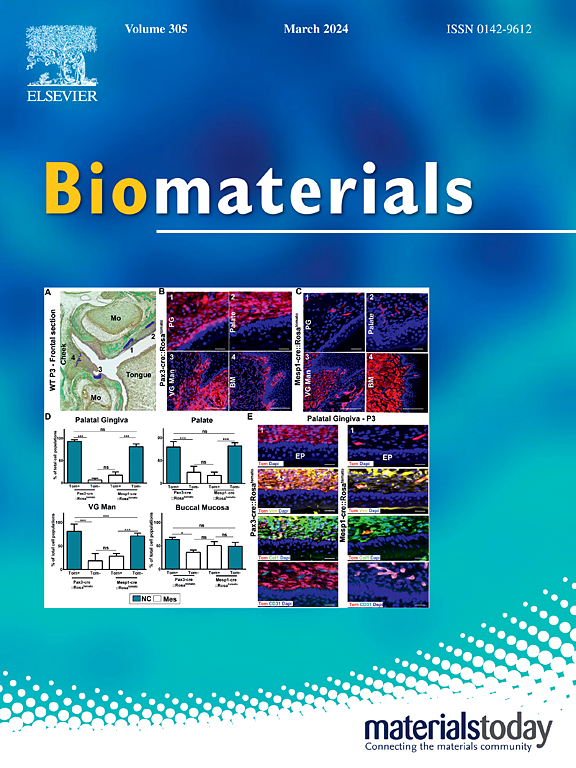Tailoring extracellular matrix niches: Impact of glycosaminoglycan content on multiple differentiation of human mesenchymal stem cells
IF 12.8
1区 医学
Q1 ENGINEERING, BIOMEDICAL
引用次数: 0
Abstract
Glycosaminoglycan (GAG) represents an important extracellular matrix (ECM), particularly in GAG-rich tissues such as nucleus pulposus and cartilage. The ratio of GAGs/hydroxyproline (HYP) is an indicator of the relative abundance of the space-filling GAG matrix to the fibrous collagen matrix in a particular tissue. Here, we hypothesize that ECM niche with different GAG/HYP ratios will affect the outcomes of multiple differentiation of human mesenchymal stem cells (hMSCs). Specifically, we fabricated collagen-based biomaterials with different GAG/HYP ratios, and differentiate hMSCs in these materials towards osteogenic, chondrogenic and discogenic lineages. In osteogenic differentiation, Collagen without GAG (GAG/HYP ratio 0) showed higher calcium (Ca) and phosphorus (P) deposition and Ca/P ratio, more biomimetic ultrastructure, and better osteogenic phenotypic expression. For chondrogenic differentiation, aminated collagen (aCol-GAG) with intermediate GAG content (GAG/HYP ratio 5.0:1) showed higher GAG deposition, more biomimetic ultrastructure, and better chondrogenic phenotype. In discogenic differentiation, aminated collagen-aminated hyaluronic acid (aHA)-GAG (aCol-aHA-GAG) with the highest GAG content (GAG/HYP ratio 19.8:1), showed intensive GAG deposition, biomimetic ultrastructure, and higher phenotypic marker expression. This study contributes to developing collagen-based biomimetic materials with different GAG/HYP ratios and suggests the use of tissue-specific GAG/HYP ratio as a scaffold design parameter for hMSCs-based musculoskeletal tissue engineering. (198 words).

求助全文
约1分钟内获得全文
求助全文
来源期刊

Biomaterials
工程技术-材料科学:生物材料
CiteScore
26.00
自引率
2.90%
发文量
565
审稿时长
46 days
期刊介绍:
Biomaterials is an international journal covering the science and clinical application of biomaterials. A biomaterial is now defined as a substance that has been engineered to take a form which, alone or as part of a complex system, is used to direct, by control of interactions with components of living systems, the course of any therapeutic or diagnostic procedure. It is the aim of the journal to provide a peer-reviewed forum for the publication of original papers and authoritative review and opinion papers dealing with the most important issues facing the use of biomaterials in clinical practice. The scope of the journal covers the wide range of physical, biological and chemical sciences that underpin the design of biomaterials and the clinical disciplines in which they are used. These sciences include polymer synthesis and characterization, drug and gene vector design, the biology of the host response, immunology and toxicology and self assembly at the nanoscale. Clinical applications include the therapies of medical technology and regenerative medicine in all clinical disciplines, and diagnostic systems that reply on innovative contrast and sensing agents. The journal is relevant to areas such as cancer diagnosis and therapy, implantable devices, drug delivery systems, gene vectors, bionanotechnology and tissue engineering.
 求助内容:
求助内容: 应助结果提醒方式:
应助结果提醒方式:


